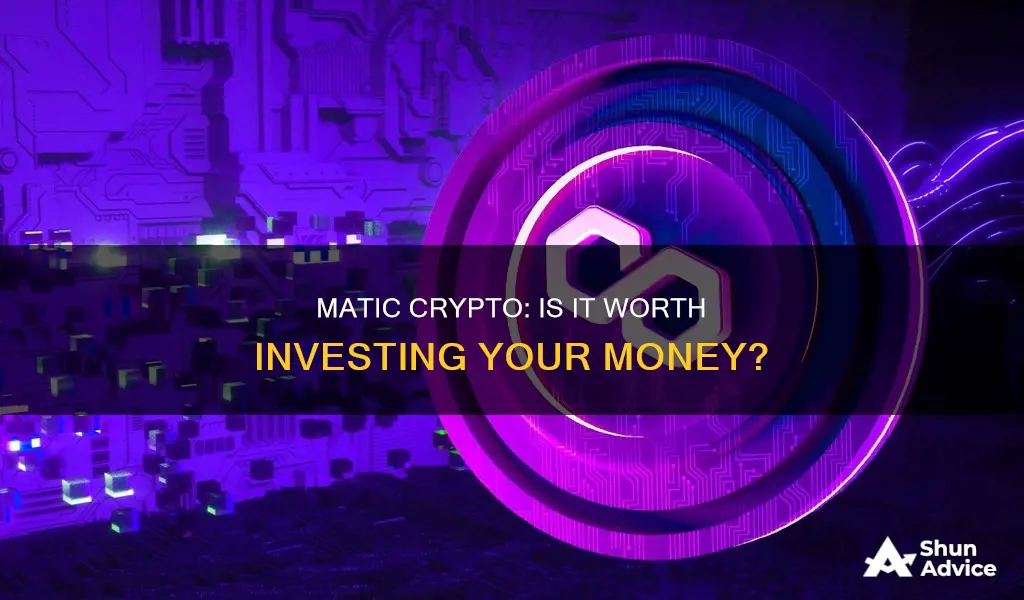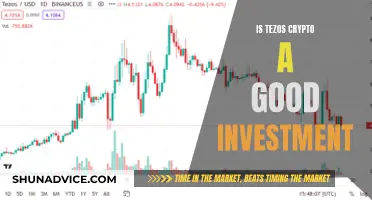
Should you invest in Matic crypto? Well, that's a tricky question. Crypto is a volatile market, and while Matic has had some impressive highs, it has also experienced some dramatic lows.
Matic, now known as Polygon, was created to scale Ethereum and improve its infrastructure. It aims to make transactions cheaper and quicker on the Ethereum blockchain. It does this by facilitating off-chain transactions before moving them onto the Ethereum main chain to finalise them, allowing it to move quickly without being slowed down by high user numbers.
Matic ended 2022 at around $1.16 and was trading for $1.25 as of 11 February 2023. It has had some impressive gains, including a 13,000% increase in 2021, but it has also experienced dramatic fluctuations, and in 2022 it suffered in a series of market crashes.
Some analysts are optimistic about Matic's future, with predictions that it could reach $10 by 2028. However, other sites are more bearish, with predictions that it could fall to below $1 in the coming months.
As with any investment, it's important to do your own research and only invest what you can afford to lose.
| Characteristics | Values |
|---|---|
| Type of Blockchain | Layer-2 scaling solution |
| Use Case | To speed up transactions on the Ethereum blockchain |
| Founders | Jaynti Kanani, Sandeep Nailwal, Anurag Arjun and Mihailo Bjelic |
| Launch Date | April 2019 |
| Launch Price | $0.00263 per token |
| Current Price | $1.25 |
| All-Time High | $2.92 |
| Market Cap | $10.93 billion |
| Circulating Supply | 8.73 billion |
| Total Supply | 10 billion |
| Use Cases | Staking on the Ethereum blockchain, paying for transactions, creating decentralised apps, smart contracts |
| Advantages | Faster and more efficient than some other blockchain networks, environmentally friendly |
| Disadvantages | Relies on Ethereum |
| Similar Networks | Avalanche, Polkadot |
What You'll Learn

Matic's price history and future predictions
Price History
MATIC, the native token of Polygon, was launched in April 2019 at a price of around $0.00263. It experienced a maximum price of $0.0450 in its first year, with a minimum price of $0.0030. In 2020, MATIC's maximum price was $0.0324, with a minimum of $0.0070.
The year 2021 was a breakthrough for MATIC, with its price reaching an all-time high of $2.92. This surge was likely driven by increased adoption and recognition of the Polygon network's potential. In 2022, MATIC continued its impressive performance, with a maximum price of $2.6015.
Future Predictions
As of September 2024, MATIC's price is around $0.37 to $0.40, with a market cap of $1,730,312,706.
- 2024 Predictions: The price of MATIC is predicted to reach a maximum of $0.75 by the end of 2024, with an average price of around $0.32. Some sources give a more bullish prediction of $0.51 for 2024.
- 2025 Predictions: For 2025, MATIC's price is expected to be between $0.41 and $0.61, with a potential high of $0.97.
- 2026-2029 Predictions: By 2026, MATIC's price could reach a maximum of $1.16, with further increases in subsequent years.
- 2030 Predictions: MATIC's price is predicted to be between $3.11 and $5.04 in 2030, with an average of around $4.36.
- Long-Term Predictions: Some sources give more optimistic long-term predictions, with MATIC potentially reaching $10 by 2033 and $15.90 by 2033.
It is important to note that cryptocurrency markets are highly volatile, and these predictions should not be considered financial advice.
Crypto Investing: A Beginner's Guide to Getting Started
You may want to see also

Matic's environmental goals
Polygon, formerly known as Matic Network, is an Ethereum token that powers the Polygon Network. It is designed to facilitate the development and scaling of Ethereum-based applications. One of the key features that sets Polygon apart is its commitment to sustainability and environmental responsibility.
Polygon's environmental goals are centred on reducing its carbon footprint and promoting a more sustainable blockchain ecosystem. The network has expressed its ambition to go carbon-negative in the near term and become "climate positive" in the future. This commitment to sustainability is a key differentiator for Polygon and has the potential to drive its adoption and attract investors who value environmentally conscious initiatives.
To achieve its sustainability goals, Polygon leverages a proof-of-stake mechanism, which is more energy-efficient than traditional proof-of-work systems. This mechanism allows users to stake their MATIC tokens to secure the network and participate in consensus, earning rewards in the process. By incentivising users to stake tokens, Polygon reduces the energy consumption associated with mining, contributing to its goal of becoming more environmentally friendly.
Additionally, Polygon's Layer 2 solution, which processes transactions off-chain before settling them on the Ethereum mainnet, also contributes to its sustainability goals. This approach reduces congestion on the Ethereum network, lowering overall energy consumption and enhancing the efficiency of transactions.
The network's dedication to sustainability is further demonstrated by its partnership with Meta to work on non-fungible tokens (NFTs). This collaboration showcases Polygon's commitment to exploring innovative solutions that align with its environmental goals while also driving the adoption of blockchain technology.
In summary, Polygon's environmental goals centre on reducing its carbon footprint and promoting sustainability within the blockchain industry. By leveraging proof-of-stake mechanisms, Layer 2 solutions, and strategic partnerships, Polygon is working towards becoming carbon-negative and, ultimately, climate positive. This commitment to environmental responsibility sets Polygon apart and has the potential to drive its long-term success and attract investors who value eco-conscious initiatives.
Elon Musk's Bitcoin Strategy: Why Invest?
You may want to see also

Matic's relationship with Ethereum
Matic, now Polygon, was initially designed to improve the Ethereum network's transaction processing speed and reduce transaction costs, otherwise known as gas fees.
Polygon, previously known as Matic Network, is the first easy-to-use platform that helps counteract problems caused by extra traffic on the Ethereum blockchain. It also works with infrastructure development.
Matic used a technology called Plasma, which processed transactions off-chain before moving them onto the Ethereum main chain to finalise them. This meant it could move quickly without being slowed down by a high user base, but it could still utilise dApps and the overall Ethereum technological ecosystem to gain a wider market.
In 2021, Matic became Polygon. The new version of the platform aimed to create a truly interoperable system of mini-blockchains, or sidechains, which would allow people to operate it with a range of blockchains.
Polygon is a framework for creating and building interconnected blockchain networks, which is particularly useful when it comes to setting up smart contracts. The most common platform for using smart contracts is Ethereum. However, Ethereum has a problem with high load times, which means the network slows down considerably.
Matic allows you to stake on the Ethereum blockchain and also pay for transactions using the currency. This has helped reduce the high transaction costs inherent in the Ethereum blockchain, helping promote widespread adoption. It supports the creation of decentralised apps and smart contracts while leveraging the benefits of Ethereum's excellent security protocols.
The MATIC token will continue to exist and will play an increasingly important role, securing the system and enabling governance. MATIC, the native token of Polygon, is an ERC-20 token running on the Ethereum blockchain. The tokens are used for payment services on Polygon and as a settlement currency between users who operate within the Polygon ecosystem. The transaction fees on Polygon sidechains are also paid in MATIC tokens.
Dogecoin Investment Guide for Nevadans: Get Started Now!
You may want to see also

Matic's scalability and transaction speed
Matic Crypto, now widely recognised as Polygon, is a transformative leap in blockchain scalability and efficiency. It aims to create a world where different blockchains can communicate and interact with each other seamlessly.
Matic Crypto was conceived with the goal of improving the scalability and user experience of decentralised apps (dApps) by leveraging a modified version of Plasma with Proof-of-Stake (PoS)-based side chains. These side chains are designed to offer faster and cheaper transactions without compromising security.
The Matic Network solves the problem of slow transactions by using a high-throughput blockchain with consensus provided by a selected set of Block Producers, chosen for every checkpoint by a set of Stakers. This helps achieve high-level decentralisation while maintaining extremely fast (2 seconds) block confirmation times.
The Matic Network also addresses the issue of low transaction throughput. It does so by using a Block Producer layer to produce blocks at a very fast rate, enabling the system to achieve up to 2^16 transactions per second on a single side chain.
Theoretically, the Matic Network can easily add more side chains horizontally to increase the total number of transactions while using the same decentralised PoS layer. This enables the network to achieve millions of transactions per second with the usage of multiple side chains.
Matic Crypto has garnered attention due to its ability to drastically reduce transaction fees while significantly increasing transaction speed on the Ethereum network. With the booming Decentralised Finance (DeFi) and Non-Fungible Token (NFT) sectors, where high gas fees and slow transaction speeds are major pain points, Polygon's solutions are particularly compelling.
The investment appeal of Matic Crypto lies in its robust technological foundation and the growing ecosystem of dApps, DeFi projects, and NFT platforms being built on Polygon. As the demand for scalable blockchain solutions increases, Polygon's native token, MATIC, has seen substantial interest from investors looking to capitalise on the growth of the Ethereum ecosystem and the broader adoption of blockchain technology.
Bitcoin Investment: Right Time to Buy?
You may want to see also

Matic's partnerships and collaborations
Matic, now known as Polygon, has formed several high-profile partnerships and collaborations over the years. Here is a detailed overview of some of these:
Nike
In November 2022, Polygon MATIC, an Ethereum token powering the Polygon network, broke an all-time price record with the number of unique addresses hitting 190.95 million. This feat was achieved amid the launch of Nike's new user-inclusive NFT marketplace, which operates on Polygon's infrastructure. Polygon recorded a 4.10% increase in value within 24 hours of the announcement of this collaboration.
Instagram, Meta, and JPMorgan
Polygon's partnership with Meta Platforms, the owner of Instagram, has enabled users to mint, display, and sell their digital artwork in-app. This integration with Instagram has also increased consumer awareness of Polygon. Additionally, Polygon has been used by JPMorgan, in collaboration with the Monetary Authority of Singapore, for its first decentralized finance transaction.
Reddit has also benefited from its partnership with Polygon, especially with the sales of their Avatar NFTs. Reddit enabled digital artists to create and mint NFTs on Polygon, which they could then sell to users as avatars. A recent analysis from Coinbase emphasised that Polygon's role as a Layer-2 solution for Ethereum enables faster transactions with lower network fees, contributing to the expedient adoption of these avatars.
Robinhood
In October 2022, Polygon announced a collaboration with Robinhood for its new Web3 wallet, allowing users to send and receive MATIC on its brokerage.
Adidas and Prada
Polygon received support from Adidas and Prada through an NFT charity project called Adidas for Prada Re-Source.
Nubank
Polygon partnered with Nubank to host its nucoin cryptocurrency.
Mir
In December 2021, Polygon announced a $400 million deal with the pioneering ZK (zero-knowledge) startup Mir, showcasing their commitment to scaling solutions.
Sequoia Capital India, Galaxy, and SoftBank
In February 2022, Polygon raised $450 million from investors, including Sequoia Capital India, Galaxy, and SoftBank, to support its Web3 plans.
These partnerships and collaborations have contributed to the growth and adoption of Polygon, enhancing its position in the crypto space.
Smog Coin: A Smart Investment Decision?
You may want to see also
Frequently asked questions
Matic is the token of the Polygon network, which is designed to improve upon existing blockchain technologies. It is traded on the Ethereum blockchain and aims to reduce high transaction costs and speed up processes.
Matic was worth about $0.00263 when it entered the market in April 2019. It reached an all-time high of $2.92 in December 2021 but has experienced volatility since, with prices dropping to $0.3228 in June 2022.
Matic has delivered impressive returns to investors, and its popularity is growing. It has been adopted by major brands like Nike, Adidas, and Prada, and it has a unique role within the Ethereum ecosystem. Its developers are also focused on sustainability, with goals to become carbon-negative and "climate positive" in the future.
Yes, Matic is subject to the volatility of the cryptocurrency market. Its value is closely tied to Ethereum, and it faces competition from other blockchain network projects like Avalanche and Polkadot. Ethereum's transition to a proof-of-stake mechanism could also impact Matic's performance.
Matic is available on most cryptocurrency exchanges, including Binance, Coinbase Pro, and UniSwap.







